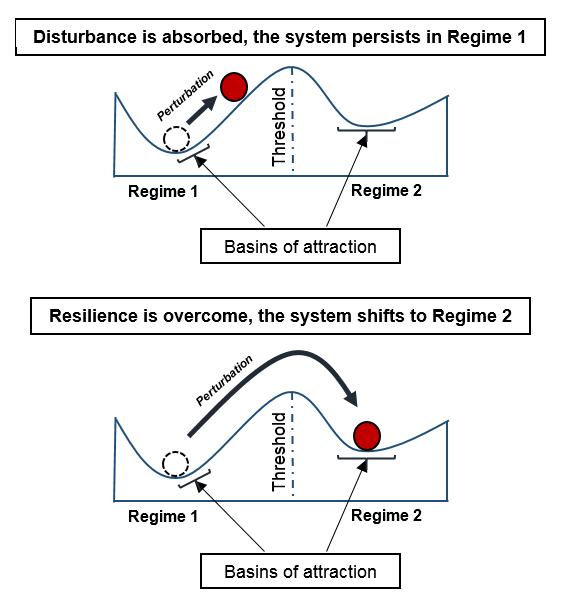IB Syllabus focus:
‘Biodiversity spans habitat, species, and genetic levels; each component strengthens ecosystem resilience by spreading risk and enabling adaptation and recovery after disturbance.’
Biodiversity ensures ecosystems remain functional and stable. By existing at habitat, species, and genetic levels, it spreads ecological risks and enhances recovery, resilience, and adaptation following environmental disturbances.
Levels of Biodiversity
Habitat Diversity
Habitat diversity refers to the variety of ecosystems or ecological niches in a given area, such as forests, wetlands, grasslands, and coral reefs.
Higher habitat diversity provides a broader range of living conditions.
It supports more species by offering multiple niches.
It contributes to stability at regional and global scales.
Habitat Diversity: The range of different habitats or ecosystems present within a particular area.
When one habitat type is degraded or lost, others may persist, maintaining overall ecosystem function.
Species Diversity
Species diversity is the variety of different species within an ecosystem, taking into account both the number of species and their relative abundances.
Greater species diversity buffers against species-specific threats such as disease or predation.
Ecosystems with more species are better equipped to maintain essential processes such as nutrient cycling, pollination, and energy transfer.
Species Diversity: The variety of species in an ecosystem, considering both richness (number of species) and evenness (distribution of individuals among species).
Genetic Diversity
Genetic diversity is the variation of genes within populations of a single species.
Populations with high genetic diversity can adapt to environmental changes more easily.
It reduces the risk of entire populations being wiped out by a single stressor.
It supports long-term survival and evolutionary potential.
Genetic Diversity: The total number of genetic characteristics in the genetic makeup of a species, allowing adaptation and survival under changing conditions.
Biodiversity and Resilience
The Role of Resilience
Resilience is the ability of an ecosystem to recover after disturbance and return to a functional state.
Biodiversity at all three levels (habitat, species, genetic) enhances resilience.
It acts as a form of insurance against environmental variability and human impact.
Resilience: The capacity of an ecosystem to resist, absorb, or recover from disturbances while maintaining essential functions and processes.

The ball-in-cup diagram shows how a system resists disturbance when the “cup” is deep and shifts state when a threshold is crossed. It provides an intuitive way to connect biodiversity to stability: multiple species and genotypes help keep the ball within a desirable basin. This figure includes a real-world grassland–woodland example that goes slightly beyond the syllabus to ground the concept. Source.
Risk-Spreading Mechanism
Biodiversity spreads risk through:
Habitat diversity: If one habitat type is destroyed, others remain to support biodiversity.
Species diversity: If one species declines, others may fulfil similar ecological roles.
Genetic diversity: If some individuals lack tolerance to stress, others may survive and reproduce.
This redundancy ensures that ecosystem services such as oxygen production, soil fertility, and food supply are not lost simultaneously.
Adaptation and Recovery
Species with high genetic diversity are more likely to have traits that withstand stress (e.g., drought tolerance).
Ecosystems with many species provide functional overlap, ensuring critical roles continue even if some species decline.
Habitat diversity enables migration and refuge for species displaced by disturbance.
Examples of Biodiversity Enhancing Resilience
Coral Reefs
Coral reefs with high species and genetic diversity recover faster from bleaching events.
Herbivorous fish maintain reef health by preventing algae overgrowth.

A coral reef community with reef-building corals and multiple fish species illustrates species and habitat diversity operating together. Such structural and taxonomic complexity spreads risk across niches and functional roles, a prerequisite for resilient responses to disturbance. This photograph is a real-world illustration rather than a diagram. Source.
Tropical Rainforests
High species richness spreads ecological roles across multiple species.
Genetic diversity in tree populations allows adaptation to pests and climate changes.
Agricultural Systems
Monocultures with low genetic diversity are vulnerable to pests.
Traditional polycultures maintain resilience by combining multiple crops, spreading risk, and preserving soil health.
Human Implications of Biodiversity and Resilience
Ecosystem Services
Biodiversity supports services vital for human survival:
Provisioning services: food, medicine, and raw materials.
Regulating services: climate regulation, flood control, disease resistance.
Supporting services: nutrient cycling, soil formation, pollination.
Cultural services: recreation, spirituality, aesthetics.
Loss of biodiversity undermines these services and decreases resilience, making human societies more vulnerable to disasters and resource shortages.
Conservation Importance
Maintaining biodiversity is central to conservation because it ensures ecosystems:
Adapt to future changes such as climate variability.
Continue providing ecosystem services.
Recover from human-driven and natural disturbances.
Key Takeaways
Biodiversity operates at three levels: habitat, species, and genetic.
Each level contributes to resilience by spreading ecological risk.
Ecosystems with high biodiversity can adapt, recover, and maintain function under environmental change.
Conservation strategies emphasise protecting all three levels to sustain ecological and human systems.
FAQ
The three levels of biodiversity—habitat, species, and genetic—do not act in isolation. Instead, they reinforce each other.
Diverse habitats provide conditions for more species.
Species diversity maintains ecosystem functions across niches.
Genetic diversity within species enhances adaptability to environmental changes.
When combined, these levels create a layered buffer against disturbance, ensuring both short-term stability and long-term survival.
Small or isolated populations often face inbreeding, reducing genetic variation. Without genetic diversity, the population may not adapt to diseases, climate shifts, or habitat changes.
High genetic diversity increases the likelihood of beneficial traits emerging. This is crucial for maintaining reproductive success and avoiding extinction when conditions change rapidly.
Functional redundancy means multiple species can perform similar ecological roles. For example, different pollinator species may all aid plant reproduction.
If one species is lost, another can maintain the function. This overlap prevents ecosystem collapse by ensuring essential processes continue despite species decline or extinction.
Habitat diversity creates options for species when part of their environment becomes unsuitable.
Disturbed habitats may drive species to migrate into neighbouring ecosystems.
Multiple habitats within a landscape increase the chance that at least some areas remain stable.
This spatial flexibility reduces the risk of total population collapse during environmental shocks.
Yes, higher biodiversity often reduces disease transmission. This effect is called the “dilution effect.”
When many species are present, disease vectors are more likely to encounter less suitable hosts. This lowers transmission rates compared to ecosystems dominated by one or two species.
In contrast, low-diversity systems often intensify outbreaks because pathogens spread easily through dense, genetically similar populations.
Practice Questions
Question 1 (2 marks)
Define species diversity and explain how it contributes to ecosystem resilience.
Mark Scheme
1 mark for a correct definition of species diversity (must mention both richness and evenness).
1 mark for linking species diversity to resilience (e.g., more species provide functional redundancy, ensuring ecosystem processes continue if one species declines).
Question 2 (5 marks)
Discuss how biodiversity at habitat, species, and genetic levels strengthens the resilience of ecosystems to environmental disturbance.
Mark Scheme
Up to 2 marks for explanation of habitat diversity (e.g., multiple habitats provide varied niches and allow species to migrate if one habitat is degraded).
Up to 2 marks for explanation of species diversity (e.g., functional overlap between species; multiple species fulfilling similar ecological roles).
Up to 2 marks for explanation of genetic diversity (e.g., populations with high genetic variation adapt better to changes such as disease or climate shifts).
Maximum 5 marks overall. Credit should be awarded for breadth (covering all three levels) and depth (clear link to resilience).

